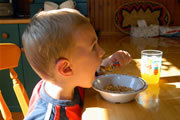Developing Motor Skills - how to help your child with shoelaces and cutlery
 The information on this page is also available to download:
The information on this page is also available to download:
Why?
Children should be given the opportunity to participate in all personal care tasks from an early age. All attempts towards independence should be encouraged.
Shoe lace tips
From an early age children will watch how you do a task and may try to do it for themselves. Encourage this and make positive comments about their attempts. Remember how hard it is to master shoelace tying and don’t forget to support your child as they begin to manage this for themselves as they may not always get it right at the start.
- Be aware that tying shoelaces is a complex skill
- Make sure your child is seated or on the floor with support from a wall or sofa behind their back
- Thick flat laces are best
- Having one red lace and one blue might help
- Begin with shoe on lap or table to practice, make sure the heel is nearest to you
- You can start by encouraging the child to do the last bit of the task so they are ‘finishing’ it and work back so over
- time the child completes each step in reverse order
- It can be helpful to break the task into two parts the ‘knot’ and the ‘loop’
- Decide on a method and try to teach that, don’t chop and change method
‘Knot’
- Learn the knot and get the child to do that every time until they are good at it
- Talk the child through the task and get them to say it as a reminder
- If the knot slips and your child can’t get tight laces you can make it no-slip by going through the ‘hole’ 2 times to make a longer knot
‘Loop’
- ‘Bunny ears’ or 2 loops method can be easier than the traditional method as you are doing the same action twice
Other fastenings
- Elastic shoe laces
- No tie curly laces
- ‘Velcro’ fastening
- Buckles
- Toggles on laces
- Or try slip ons
Cutlery tips
Children very early on want to hold a spoon and be involved in feeding themselves. Do encourage this but be prepared for mess. Start with a spoon. You can use two spoons, one for you to feed child with and one for the child.
Sit down together at the table at mealtimes to demonstrate how to use cutlery
- Use a non slip mat or damp cloth to keep the bowl or plate still
- Guide your child’s hand with yours to demonstrate cutting, stabbing and spreading
- Practice cutting and stabbing skills with play dough or plasticine
- Encourage spreading action using glue, shaving foam etc using a spreader and then knife
- Use foods that are easy to cut initially ie fish fingers, hot dogs, bread and butter
- Use appropriate sized children’s cutlery available from Boots, Ikea and other stores
- A sticker can be placed on your child’s knuckles for them to focus on, this will help to prevent turning the fork or spoon upside down before entering the mouth

